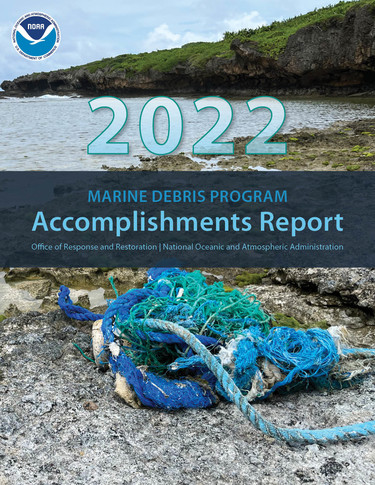 The NOAA Marine Debris Program is proud to present our 2022 Accomplishments Report. The report is a snapshot of the work of the Marine Debris Program and our partners throughout the fiscal year. Although the problem of marine debris continues to present challenges for wildlife, habitats, and people across the United States and around the world, the community working to solve this global problem is stronger than ever. We are proud to be a part of this community and contribute to solutions as the United States Government’s lead on the issue of marine debris.
Learn More
Hawai‘i Wildlife Fund regularly conducts net patrols and cleanups to remove large-scale debris including nets (Credit: Hawai‘i Wildlife Fund).
Marine debris of all types continue to be a problem for island communities across the Pacific. Despite the marine debris problem in the Pacific, dedicated organizations and ocean stewards are working on projects to remove derelict fishing gear, clean up typhoon debris, offer alternatives to commonly used single-use plastic items, and much more. The NOAA Marine Debris Program is proud to support these partners and projects throughout the Pacific Islands region.
Learn More
A dive team returning to shore after a marine debris cleanup for the Goal: Clean Seas Florida Keys project (Credit: Sean Davis).
Throughout the year, the NOAA Marine Debris Program will spotlight each region for an entire month. Take a look back at the Florida projects we highlighted in January.
Florida is unique as the only state that borders both the Atlantic Ocean and the Gulf of Mexico. No matter where you are in the state, you’re never more than 60 miles from the nearest body of water. It also means that the daily choices and activities of Florida’s residents and visitors can easily lead to debris in our coastal and marine habitats. Luckily, our partners across the region are kicking off the New Year with renewed energy and effort in leading marine debris removal and prevention projects to keep Florida’s waters healthy and free of debris.
Learn More
Eckerd College students sorting through debris collected during a beach clean-up (Credit: Angelina Kossoff).
Eckerd College, located along the sunny coast of the Gulf of Mexico, has been working hard to reduce single-use plastic consumption on campus for years. Following a successful NOAA Marine Debris Program prevention grant focused on reducing single-use plastic at Eckerd, the Reduce Single-Use Project teamed up with the University of North Florida in Jacksonville. On both campuses the team has encouraged college students to rely less on plastics through events, beach cleanups, and even an app.
Learn More
A happy airboater returns with a full load of ghost traps during a Ghost Trap Rodeo event (Credit: Ocean Aid 360).
Since our very first event in St. Petersburg, Florida, the Ocean Aid 360 Ghost Trap Rodeo, which resembles an all-ages fishing tournament with prizes, has engaged 1,085 volunteers in 22 events, from the Florida Panhandle to Key West and the Bahamas. Over that time, these participating boaters, anglers, paddlers, and beachcombers have helped Ocean Aid 360 find and remove over 162,000 pounds of marine debris, including 2,591 derelict crab and lobster traps left abandoned during seasonal closures.
Learn More
A crew hauls a tangle of fishing nets into a boat at Pearl and Hermes Atoll during a cleanup in the Papahānaumokuākea Marine National Monument (Credit: NOAA).
Later this month we're celebrating World Whale Day, and we want to highlight that whales are one of the many kinds of wildlife that are impacted by marine debris. Nets, ropes, and other derelict fishing gear that are abandoned or lost at sea pose a serious threat. When animals are caught in marine debris it can be difficult to swim and feed, cut into their bodies, and potentially lead to death. Learn more about marine debris and wildlife entanglement.
Learn More
|